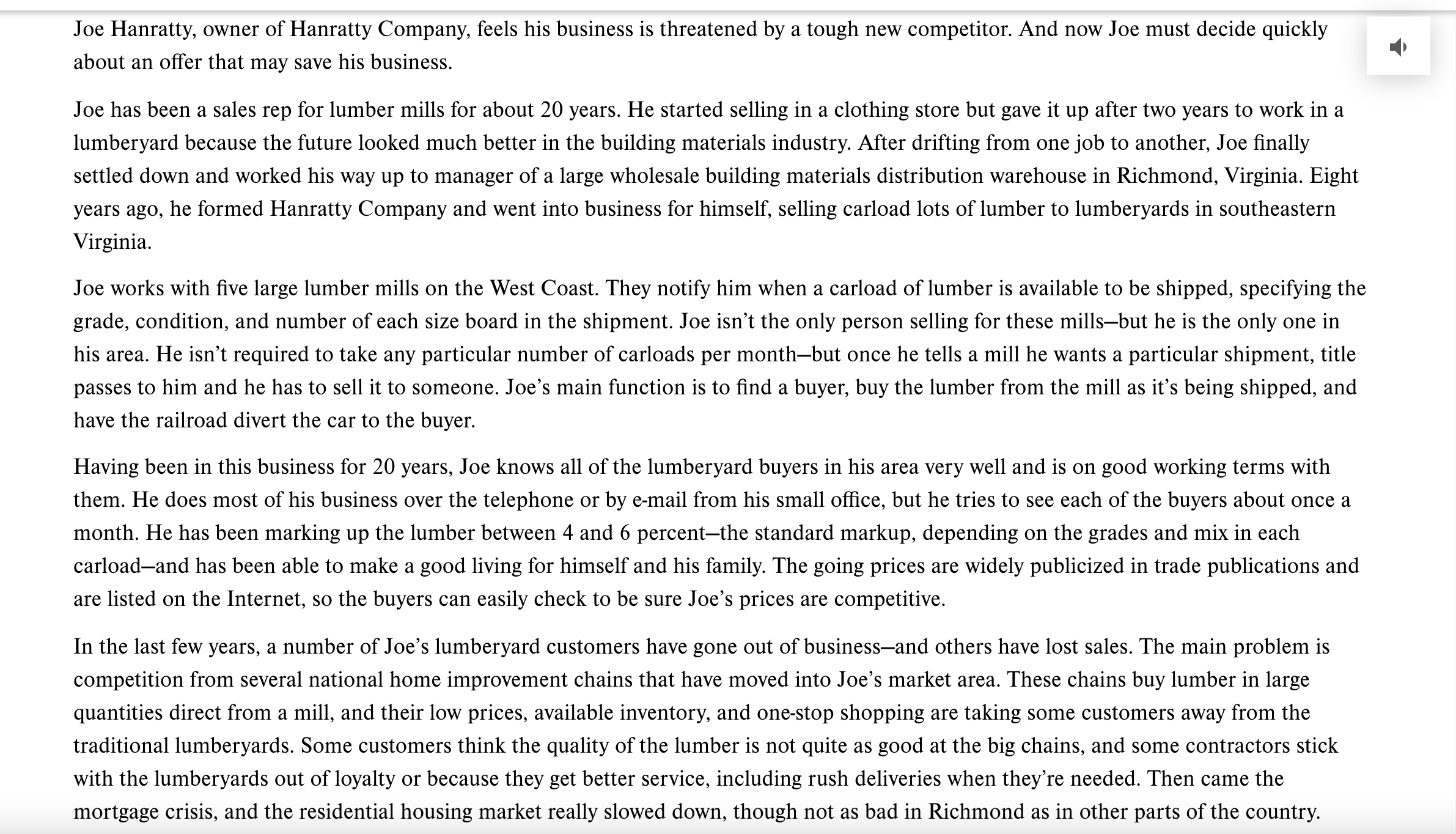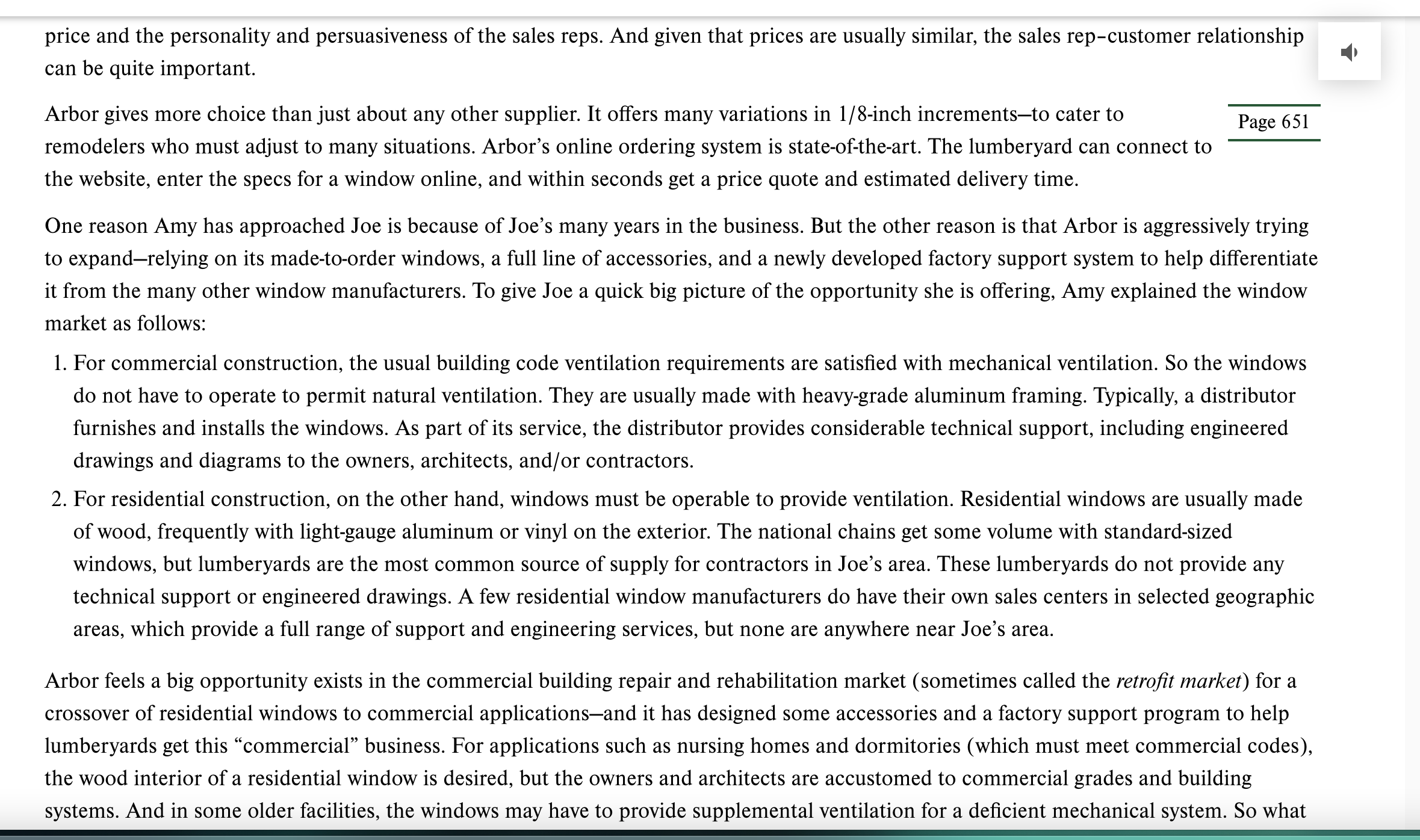1. With Joe's current business of selling the lumber isJoe Hanratty a wholesaler and if so what typeand explain the type.
2. Would Joe still be the same type of wholesaler as before if he took the Arbor offer ? Please explain
3. What are the advantages of the Arbor offer over what Joes current job?
4. Evaluate the three choices and indicate which is the best choice for Joe. Please explain your selection.
Reading material:
4| Joe Hanratty, owner of Hanratty Company, feels his business is threatened by a tough new competitor. And now Joe must decide quickly about an offer that may save his business. Joe has been a sales rep for lumber mills for about 20 years. He started selling in a clothing store but gave it up after two years to work in a lumberyard because the future looked much better in the building materials industry. After drifting from one job to another, Joe nally settled down and worked his way up to manager of a large wholesale building materials distribution warehouse in Richmond, Virginia. Eight years ago, he formed Hanratty Company and went into business for himself, selling carload lots of lumber to lumberyards in southeastern Virginia. Joe works with ve large lumber mills on the West Coast. They notify him when a carload of lumber is available to be shipped, specifying the grade, condition, and number of each size board in the shipment. Joe isn't the only person selling for these millsbut he is the only one in his area. He isn't required to take any particular number of carloads per monthbut once he tells a mill he wants a particular shipment, title passes to him and he has to sell it to someone. Joe's main function is to nd a buyer, buy the lumber from the mill as it's being shipped, and have the railroad divert the car to the buyer. Having been in this business for 20 years, Joe knows all of the lumberyard buyers in his area very well and is on good working terms with them. He does most of his business over the telephone or by e-mail from his small oice, but he tries to see each of the buyers about once a month. He has been marking up the lumber between 4 and 6 percentthe standard markup, depending on the grades and mix in each carloadand has been able to make a good living for himself and his family. The going prices are widely publicized in trade publications and are listed on the Internet, so the buyers can easily check to be sure Joe's prices are competitive. In the last few years, a number of Joe's lumberyard customers have gone out of businessand others have lost sales. The main problem is competition from several national home improvement chains that have moved into Joe's market area. These chains buy lumber in large quantities direct from a mill, and their low prices, available inventory, and one-stop shopping are taking some customers away from the traditional lumberyards. Some customers think the quality of the lumber is not quite as good at the big chains, and some contractors stick with the lumberyards out of loyalty or because they get better service, including rush deliveries when they're needed. Then came the mortgage crisis, and the residential housing market really slowed down, though not as bad in Richmond as in other parts of the country. Fortunately for Joe, the commercial market remained pretty strong and he had good relationships thereor Joe's prots would have taken an even bigger hit. Six months ago, though, things got even worse. An aggressive young salesman set up in the same business, covering about the same area but representing different lumber mills. This new salesman charges about the same prices as Joe but undersells him once or twice a week in order to get the sale. On several occasions he even set up what was basically an online auction to quickly sell excess wood that was not moving fast enough. Many lumber buyersfeeling the price competition from the big chains and realizing that they are dealing with a homogeneous productseem to be willing to buy from the lowest-cost source. This has hurt Joe nancially and personallybecause even some of his old friends are willing to buy from the new competitor if the price is lower. The near-term outlook seems dark, because Joe doubts that there is enough business to support two rms like his, especially if the markup gets shaved any closer. Now they seem to be splitting the shrinking business about equally, as the newcomer keeps shaving his markup. A week ago, Joe was called on by Amy Balderas of Arbor Door and Window Co., a large manufacturer of windows, raised-panel doors, and accessories. Arbor doesn't sell to the big chains and instead distributes its quality line only through independent lumberyards. Amy knows that Joe is well acquainted with the local lumberyards and wants him to become Arbor's exclusive distributor (sales rep) of residential windows and accessories in his area. Amy gave Joe several brochures on Arbor's product lines. She also explained Arbor's new support program, which will help train and support Joe and interested lumberyards on how to sell the higher-markup accessories. Later, in a lengthy e-mail, Amy explained how this program will help Joe and interested lumberyards differentiate themselves in this very competitive market. Most residential windows of specied grades are basically \"commodities\" that are sold on the basis of price and availability, although some premium and very low-end windows are also sold. The national home-improvement chains usually stock and sell only the standard sizes. Most independent lumberyards do not stock windows because there are so many possible sizes. Instead, the lumberyards custom-order from the stock sizes each factory offers. Stock sizes are not set by industry standards; they vary from factory to factory, and some offer more sizes. Most factories can deliver these custom orders in two to six weeks, which is usually adequate to satisfy contractors who buy and install them according to architectural plans. This part of the residential window business is well established, and most lumberyards buy from several different window manufacturersto ensure sources of supply in case of strikes, plant res, and so on. How the business is split depends on 4t price and the personality and persuasiveness of the sales reps. And given that prices are usually similar, the sales repcustomer relationship can be quite important. Arbor gives more choice than just about any other supplier. It oers many variations in 1/ 8-inch incrementsto cater to Page 651 remodelers who must adjust to many situations. Arbor's online ordering system is stateof-the-art. The lumberyard can connect to the website, enter the specs for a window online, and within seconds get a price quote and estimated delivery time. One reason Amy has approached Joe is because of Joe's many years in the business. But the other reason is that Arbor is aggressively trying to expandrelying on its made-toorder windows, a full line of accessories, and a newly developed factory support system to help differentiate it from the many other window manufacturers. To give Joe a quick big picture of the opportunity she is offering, Amy explained the window market as follows: 1. For commercial construction, the usual building code ventilation requirements are satised with mechanical ventilation. So the windows do not have to operate to permit natural ventilation. They are usually made with heavy-grade aluminum framing. Typically, a distributor furnishes and installs the windows. As part of its service, the distributor provides considerable technical support, including engineered drawings and diagrams to the owners, architects, and/or contractors. 2. For residential construction, on the other hand, windows must be operable to provide ventilation. Residential windows are usually made of wood, frequently with light-gauge aluminum or vinyl on the exterior. The national chains get some volume with standard-sized windows, but lumberyards are the most common source of supply for contractors in Joe's area. These lumberyards do not provide any technical support or engineered drawings. A few residential window manufacturers do have their own sales centers in selected geographic areas, which provide a full range of support and engineering services, but none are anywhere near Joe's area. Arbor feels a big opportunity exists in the commercial building repair and rehabilitation market (sometimes called the retrot market) for a crossover of residential windows to commercial applicationsand it has designed some accessories and a factory support program to help lumberyards get this \"commercial\" business. For applications such as nursing homes and dormitories (which must meet commercial codes), the wood interior of a residential window is desired, but the owners and architects are accustomed to commercial grades and building systems. And in some older facilities, the windows may have to provide supplemental ventilation for a decient mechanical system. So what systems. And in some older facilities, the windows may have to provide supplemental ventilation for a decient mechanical system. So what '0 is needed is a combination of the residential operable window with a heavy-gauge commercial exterior frame that is easy to specify and install. And this is what Arbor is offering with a combination of its basic windows and easily adjustable accessory frames. Two other residential window manufacturers offer a similar solution, but neither has pushed its products aggressively and neither offers technical support to lumberyards or trains sales reps like Joe to do the necessary job. Amy feels this could be a unique opportunity for Joe. The sales commission on residential windows would be about 5 percent of sales. Arbor would do the billing and collecting. By getting just 20 to 30 percent of his lumberyards' residential window business, Joe could earn about a third of his current income. But the real upside would come in the long term by increasing his residential window share. Joe is condent that the housing market will turn around soon, and when it does he will be well positioned for growth. To do this, he will have to help the lumberyards get a lot more (and more protable) business by invading the commercial market with residential windows and the bigger-markup accessories needed for this market. Joe will also earn a 20 percent commission on the accessories, adding to his prot potential. Joe is somewhat excited about the opportunity because the retrot market is growing. And owners and architects are seeking ways of reducing costs (which Arbor's approach doesover usual commercial approaches). He also likes the idea of developing a new line to offset the slow-growing market for new-construction housing. But he is concerned that a lot of sales effort will be needed to introduce this new idea. He is not afraid of work, but he is concerned about his nancial survival. Joe thinks he has three choices: 1. Take Amy's offer and sell both window and lumber products. 2. Take the offer and drop lumber sales. 3. Stay strictly with lumber and forget the offer. Amy is expecting an answer within one week, so Joe has to decide soon










